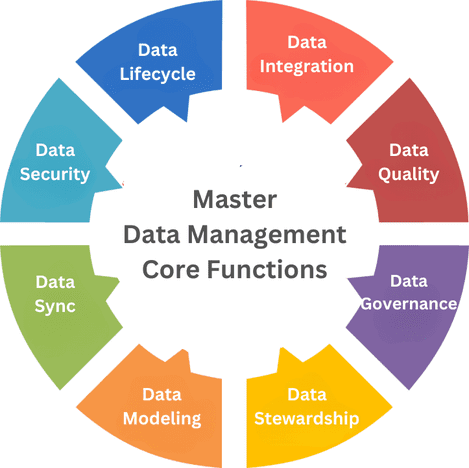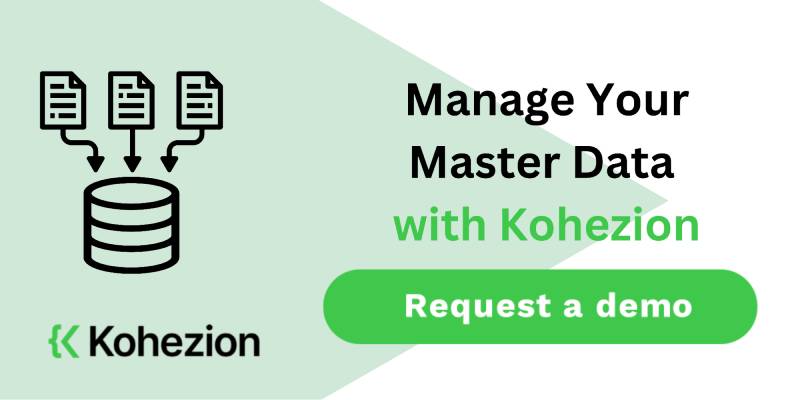Did you know that poor data quality costs businesses about $3.1 trillion each year? This shows how important it is to have good master data management (MDM) practices. They help keep your data accurate and consistent across all areas of your business.
There master data management best practices will help you with data governance, making better decisions, and improving how things work. With strong MDM strategies, you can bring together and improve your important data. This leads to better insights and helps your business stay agile in the market.
What Is Master Data Management?
Master Data Management (MDM) is a method used by organizations to define, manage, and maintain their critical data, ensuring it is accurate, consistent, and available across the entire organization.
It centralizes and streamlines the handling of essential business information such as customer data, product details, and supplier information, providing a single, reliable source of truth for decision-making and operational processes.
Types of Master Data
Knowing the different types of master data is key to good data management in any company. Each type plays a special role that boosts various business processes. Here, we'll explore the main types of master data and why they matter for managing customer info, product details, and more.
Customer Data
Customer data covers all info about your customers. It helps in managing relationships, shaping sales plans, and boosting customer happiness. Good customer data management helps with targeted marketing and higher customer satisfaction.
Product Data
Product data talks about what your company sells. It's key for keeping track of stock, planning marketing, and sales tactics. Handling product data well helps keep the right amount of stock and meet market needs.
Supplier Data
Supplier master data has important details about your suppliers. It's vital for buying goods, managing the supply chain, and keeping strong business ties. Good supplier data management means better prices, reliability, and smoother operations.
Employee Data
Employee information is all about your team. It's important for HR, talking to employees, and following the law. Keeping employee data right helps with managing the team and boosting employee involvement.
Location Data
Location data gives insights into your company's places, like stores and warehouses. Managing this data well is key for planning logistics, checking property values, and running smoothly in different areas.
Asset Data
Asset data tracks both physical and intellectual assets. It's key for financial reports and getting the most out of assets. A good asset database helps with making smart choices and better financial management.
Financial Data
Financial data includes records that show your company's money situation, like sales figures and ledgers. Managing this data well is key for planning, reporting, and following the law. It helps with making smart money decisions and staying financially healthy.

Why Is Master Data Management Important?
Master Data Management (MDM) is key in today's data-driven world. It gives you one place for all important info. This makes getting data easier and cuts down on mistakes that can cause confusion.
Good master data helps make better decisions. Companies that focus on quality data get insights that lead to new ideas and growth. With the right info, teams can make fast, smart moves, making the business run smoother.
MDM is vital for keeping things running smoothly. It helps follow rules and manage data well. Bad or inconsistent data can slow things down, increase risks, and miss chances. Seeing the value of MDM helps companies stay ahead and be flexible and big.
What Are the Primary Functions of Master Data Management?
Master Data Management (MDM) is key to keeping data precise and easy to reach. It has many processes that boost data quality and use. Knowing these functions helps manage data well and makes better decisions.
Data Integration
Data integration uses techniques to smoothly move information between systems. This makes sure data from different sources comes together right, helping with business tasks.
Data Quality Management
Keeping data quality high means always checking and managing it. This includes strict rules to make sure data is correct, full, and the same everywhere.
Data Governance
Data governance sets up rules for using and following data rules. It makes sure data use is clear and safe, keeping sensitive info secure.
Data Stewardship
Data stewardship gives some people the job of looking after data quality and following rules. Good stewardship makes the data management plan stronger.
Data Modeling
Data modeling shows how data connects visually. A good data model makes it clear how different data pieces link, making data easier to manage.
Data Synchronization
Keeping data up-to-date means all systems have the latest, right info. This lowers risks from old data, making things run smoother.
Data Security and Privacy
Keeping sensitive info safe is a must. Strong security and privacy steps stop unauthorized access and follow the law, building trust with everyone involved.
Data Lifecycle Management
Data lifecycle management says how to handle data from start to end. Keeping the right data and getting rid of old info makes managing data better.

Master Data Management Best Practices
Using MDM best practices is key to making data better and more relevant. Each practice helps manage data well, making sure your business gets the most from its data.
Define Clear Objectives
Setting clear goals is the first step in effective MDM. These goals help guide your MDM efforts and make sure they match your business needs and goals.
Secure Executive Sponsorship
Getting support from top leaders is crucial. They provide the needed resources and make sure MDM gets the priority it needs in the company.
Implement Strong Data Governance
Having strong data governance means setting clear rules for who does what with the data. This makes managing data clear and helps in making good decisions.
Ensure Data Quality
Checking and improving data quality is key. Using automated tools for cleaning and checking data helps keep standards high. This supports making reliable decisions.
Choose the Right MDM Tools
Picking the right MDM tools is important. Look for tools that work well with your current data systems. This makes integration smooth and helps improve data quality.
Engage Data Stewards
Data stewards keep data quality and integrity up to standard. Their knowledge is key in following rules and strengthening the data governance framework.
Focus on Data Integration
Good data integration strategies are needed to bring together different data sources. This makes information across your organization clear and easy to access.
Develop a Data Model
A structured data model shows how data relates and what it means. This model is key in managing and analyzing data well, following MDM best practices.
Establish Data Security and Privacy Measures
Keeping data safe and private is a must. Following rules and using best practices in protecting data keeps sensitive info safe. This builds trust with everyone involved.
Provide Training and Support
Teaching your team about MDM practices makes them more effective. Regular training and support keep everyone on the same page with data governance.
Monitor and Evaluate Performance
Checking how well your data management is doing helps spot areas to get better. Regular checks improve processes and build a culture of responsibility.
Promote Continuous Improvement
Encouraging a culture of always looking to get better is important. This focus on continuous improvement keeps your organization agile and ready to adapt to new business needs.
| Best Practice | Description | Impact on MDM |
| Define Clear Objectives | Establish specific goals tailored to business needs. | Guides initiatives and aligns strategies. |
| Secure Executive Sponsorship | Gain leadership commitment to prioritize MDM. | Provides essential resources. |
| Implement Strong Data Governance | Develop formal policies for data oversight. | Enhances accountability and effectiveness. |
| Ensure Data Quality | Regular assessments and validation techniques. | Improves reliability of data. |
| Choose the Right MDM Tools | Select compatible tools with business requirements. | Facilitates seamless integration. |
| Engage Data Stewards | Appoint personnel responsible for data management. | Ensures adherence to quality standards. |
| Focus on Data Integration | Create strategies for unifying data sources. | Enhances coherence and accessibility. |
| Develop a Data Model | Establish a structured framework of data. | Facilitates effective management and analysis. |
| Establish Data Security and Privacy | Adhere to regulations for data protection. | Builds trust and safeguards information. |
| Provide Training and Support | Equip staff with knowledge of MDM practices. | Enhances effectiveness of data management. |
| Monitor and Evaluate Performance | Track initiatives to identify improvements. | Reinforces accountability and optimization. |
| Promote Continuous Improvement | Encourage ongoing evaluation of data processes. | Ensures adaptability to business changes. |
Improve Your Master Data Management with Kohezion
Enhance your business operations and data accuracy with Kohezion's Master Data Management solutions. Our platform simplifies the management of critical data, ensuring it is consistent, accurate, and easily accessible across your organization.
Take control of your master data and drive better decision-making with Kohezion. Start your journey towards efficient data management today by exploring Kohezion's innovative solutions!
Conclusion
Having a strong MDM plan helps you deal with the fast-changing digital world. With these best practices, you follow the rules and stay ahead of the competition. This shows how important it is to use correct and dependable data for growth.
Putting time and effort into MDM makes sure your data is safe and easy to get to. This leads to better decisions, plans, and success over time. With a focus on good data management and quality, you're ready for a future where data insights are key.
Start building with a free account
Frequently Asked Questions
MDM supports regulatory compliance, as it ensures that data is accurate, consistent, and traceable. It helps organizations adhere to data-related regulations such as GDPR, HIPAA, and CCPA, as it maintains a robust data governance and data quality practices.
While MDM traditionally focuses on structured data, it can also be applied to unstructured data with the help of advanced data integration and management tools. These tools can extract, transform, and manage unstructured data, ensuring it aligns with the organization’s master data standards.
MDM focuses on the management and maintenance of master data to ensure it is accurate, consistent, and available. Data governance, on the other hand, is a broader framework that includes policies, procedures, and standards for managing all data assets within an organization. MDM is a component of data governance.

